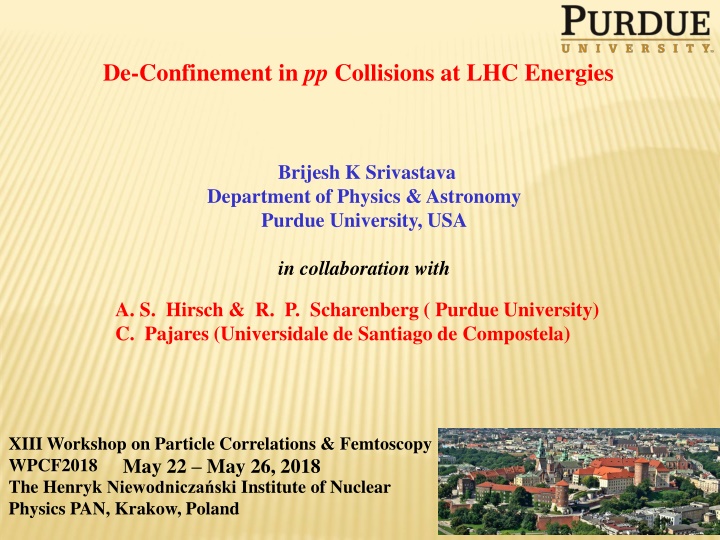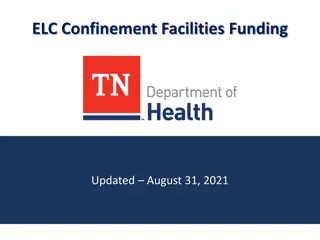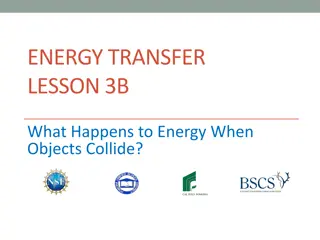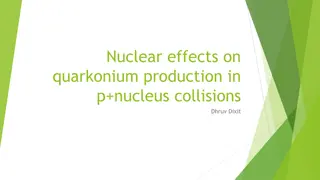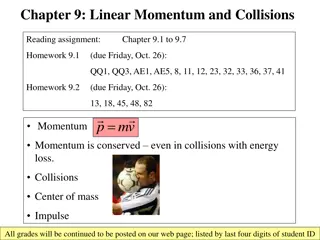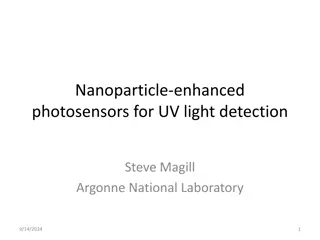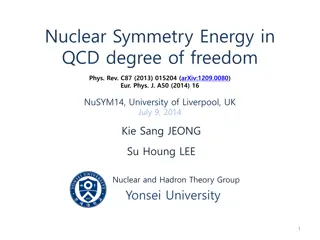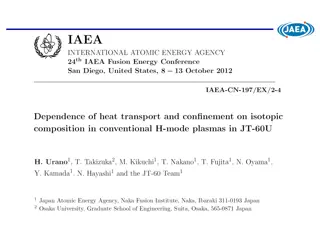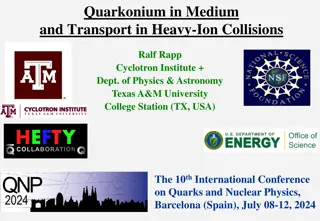Insight into De-Confinement in High-Energy Nuclear Collisions
Explore the phenomena of de-confinement and clustering of color sources in nuclear collisions, revealing the transition to a state where quarks and gluons cannot be confined into color-neutral hadrons. This study delves into the relationship between percolation theory and de-confinement, shedding light on the behavior of color strings and their impact on particle production at high energies.
Download Presentation

Please find below an Image/Link to download the presentation.
The content on the website is provided AS IS for your information and personal use only. It may not be sold, licensed, or shared on other websites without obtaining consent from the author.If you encounter any issues during the download, it is possible that the publisher has removed the file from their server.
You are allowed to download the files provided on this website for personal or commercial use, subject to the condition that they are used lawfully. All files are the property of their respective owners.
The content on the website is provided AS IS for your information and personal use only. It may not be sold, licensed, or shared on other websites without obtaining consent from the author.
E N D
Presentation Transcript
De-Confinement in pp Collisions at LHC Energies Brijesh K Srivastava Department of Physics & Astronomy Purdue University, USA in collaboration with A. S. Hirsch & R. P. Scharenberg ( Purdue University) C. Pajares (Universidale de Santiago de Compostela) XIII Workshop on Particle Correlations & Femtoscopy WPCF2018 The Henryk Niewodnicza ski Institute of Nuclear Physics PAN, Krakow, Poland May 22 May 26, 2018 1
UA5 UA1 2
E735 DATA T.Alexopoulos, PRD48, 984 (1993) 4
De-Confinement and Clustering of Color Sources In Nuclear Collisions 6
Color Strings Multiparticle production at high energies is currently described in terms of color strings stretched between the projectile and target. q q These strings decay into new ones by production and subsequently hadronize to produce the observed hadrons. Particles are produced by the Schwinger 2D mechanism. As the no. of strings grow with energy and or no. of participating nuclei they start to interact and overlap in transverse space as it happens for disks in the 2-D percolation theory In the case of a nuclear collisions, the density of disks elementary strings Ns = # of strings S1 = Single string area SN = total nuclear overlap area s N S 1 = S N 7
Clustering of Color Sources De-confinement is expected when the density of quarks and gluons becomes so high that it no longer makes sense to partition them into color-neutral hadrons, since these would overlap strongly. We have clusters within which color is not confined : De-confinement is thus related to cluster formation very much similar to cluster formation in percolation theory and hence a connection between percolation and de-confinement seems very likely. Parton distributions in the transverse plane of nucleus-nucleus collisions In two dimensions, for uniform string density, the percolation threshold for overlapping discs is: c . 1 = 18 H. Satz, Rep. Prog. Phys. 63, 1511(2000). H. Satz , hep-ph/0212046 Critical Percolation Density 8
Color Sources Sn The transverse space occupied by a cluster of overlapping strings split into a number of areas in which different no of strings overlap, including areas where no overlapping takes place. A cluster of n strings that occupies an area Sn behaves as a single color source with a higher color field corresponding to vectorial sum of color charges of each individual string 1 Q Q n = If strings are fully overlap 2 n 2 Q nQ 1 S S Partially overlap = 2 n 2 n Q n Q 1 1 9
Schwinger mechanism for the Fragmentation Multiplicity and <pT2 > of particles produced by a cluster of n strings Multiplicity ( n) ( n F = Average Transverse Momentum 2 T 2 T s = / ( ) p p F ) N 1 n 1 s N S 1 = 1 e S = Color suppression factor (due to overlapping of discs). N ( = ) F Ns = # of strings S1 = disc area SN = total nuclear overlap area is the string density parameter M. A. Braun and C. Pajares, Eur.Phys. J. C16,349 (2000) M. A. Braun et al, Phys. Rev. C65, 024907 (2002) 10
Percolation and Color Glass Condensate Both are based on parton coherence phenomena. Percolation : Clustering of strings CGC : Gluon saturation Many of the results obtained in the framework of percolation of strings are very similar to the one obtained in the CGC. In particular , very similar scaling laws are obtained for the product and the ratio of the multiplicities and transverse momentum. Both provide explanation for multiplicity suppression and <pt> scaling with dN/dy. Momentum Qs establishes the scale in CGC with the corresponding one in percolation of strings The no. of color flux tubes in CGC and the effective no. of clusters of strings in percolation have the same dependence on the energy and centrality. This has consequences in the Long range rapidity correlations and the ridge structure. 2 t k p 2 s 1 = Q ( ) F For large value of s Q 2 11 CGC : Y. V. Kovchegov, E. Levin, L McLerran, Phys. Rev. C 63, 024903 (2001).
Color String Percolation Model for Nuclear Collisions from SPS-RHIC-LHC Elementary partonic collisions 1. Multiplicity 2. pt distribution 3. Particle ratios 4. Elliptic flow 5. Suppression of high pt particles RAA 6. J/ production 7. Forward-Backward Multiplicity Correlations at RHIC Formation of Color String SU(3) random summation of charges Reduction in color charge Increase in the string tension String breaking leads to formation of secondaries Probability rate ->Schwinger Fragmentation proceeds in an iterative way 12
Thermodynamic and Transport Properties Determination of the Color Suppression Factor F( ) from the Data Thermodynamics Temperature Energy Density Shear viscosity to Entropy density ratio Equation of State 13
Data Analysis Using the pT spectrum to extract F( ) The experimental pT distribution from pp data is used 2 d N a = + Parametrization of UA1 data from 200, 500 and 900 GeV ISR 53 and 23 GeV pp p0 = 1.71 and n = 12.42 Nucl. Phys. A698, 331 (2002) pp 2 n ( ) d t p p pt 0 a, p0 and n are parameters fit to the data. This parameterization can be used for nucleus-nucleus collisions to account for the clustering : Au+Au@200 GeV 0-10% 2 d N b = 2 n dpt ( ) F F + pp p pt 0 ( ) AuA u F = ( ) 1 pp pp@200 GeV 14
Color Suppression Factor F() Au+Au @200 GeV STAR data Phys. Rev. C 79, 034909(2009) Using ALICE charged particle multiplicity Phys. Rev. Lett. , 106, 032301 (2011). Extrapolation 1 e ( = ) F Now the aim is to connect F( ) with Temperature and Energy density 15
Schwinger : pt distribution of the produced quarks Thermal Distribution 2 t p dn ~ exp( ) p dn t 2 2 ~ exp( ) d p k 2 d p T The Schwinger formula can be reconciled with the thermal distribution if the String tension undergoes fluctuations 2 k 2 2 k T = = ( ) exp P k dk dk 2 2 2 2 k k which gives rise to thermal distribution 2 k dn Initial temperature ~ exp p 2 2 d p 2 t 2 t 2 p p k 2 t 1 = = = p 1 T 2 ( ) F ( ) F 16
Thermalization The origin of the string fluctuation is related to the stochastic picture of the QCD vacuum . Since the average value of color field strength must vanish, it cannot be constant and must vanish from point to point. Such fluctuations lead to the Gaussian distribution of the string. H. G. Dosch, Phys. Lett. 190 (1987) 177 A. Bialas, Phys. Lett. B 466 (1999) 301 The fast thermalization in heavy ion collisions can occur through the existence of event horizon caused by rapid deceleration of the colliding nuclei. Hawking-Unruh effect encountered in black holes and for accelerated objects. D. Kharzeev, E. Levin , K. Tuchin, Phys. Rev. C75, 044903 (2007) H.Satz, Eur. Phys. J. 155, (2008) 167 17
Temperature 2 t p = 1 T 2 ( ) F At the critical percolation density 2 . 1 = c For Au+Au@ 200 GeV 0-10% centrality = 2.88 T ~ 195 MeV PHENIX: Temperature from direct photon Exponential (consistent with thermal) Inverse slope = 220 20 MeV PRL 104, 132301 (2010) cT = 167 MeV Pb+Pb @ 2.76TeV for 0-5% T =262 13 MeV Temperature has increased by 35% from Au+Au @ 0.2 TeV First Results from Pb+Pb Collisions@ 2.76 TeV at the LHC Muller, Schukraft and Wyslouch, Ann. Rev. Nucl. Sci. Oct. 2012 ALICE : Direct Photon Measurement T = 304 51 MeV QM2 2012 T = 297 12 41MeV Phys. Lett. B 754 , 235 (2016) 18
Summary : Heavy Ion The Clustering of Color Sources leading to the Percolation Transition may be the way to achieve de-confinement in High Energy collisions. This picture provide us with a microscopic partonic structure which explains the early thermalization. The relevant quantity is transverse s N S 1 = string density S N A further definitive test of clustering phenomena can be made at LHC energies by comparing h-h and A-A collisions. Braun, Dias de Deus, Hirsch, Pajares, Scharenberg and Srivastava Phys. Rep. 599 (2015) 1-50 19
Application of Clustering Picture to Small System ppat 1.8 TeV E-735 experiment at FNAL pp at LHC energies 0.9, 2.76, 7 and 13 TeV Determination of the Color Suppression Factor F ( ) using transverse momentum spectra of pions in high multiplicity events Temperature Comparison between AA and pp 20
and A further definitive test of clustering phenomena can be made at LHC energies 21
CMS Collaboration arXiv:1706.10194 , Phys. Rev. D 96 (2017) 112003 22
Analysis of CMS data to extract Color Suppression Factor F() from the transverse momentum spectra of pions at 0.9, 2.76 , 7 and 13 TeV as a function of multiplicity (Ntrack) 1 e ( = ) F Pseudorapidity coverage for CMS : | | < 2.4 E735: | | < 3.25 23
F() from AA and pp Fixed interaction cross section for all multiplicities in pp 24
Interaction area is computed: IP-Glasma model The gluon multiplicity can be approx. related to the no of tracks seen in the CMS experiment dN dy 3 1 2 g K N track = 2 pp S R Transverse area : pp 25
Scaling with the transvers interaction area S S varies with the multiplicity and is obtained using the methodology Described by CGC 1 e ( = ) F E735 and Au+Au at 200 GeV are also shown in the plot. It scales with the Transverse overlap area. 26
Temperature 2 t p = 1 T Universal hadronization temperature 2 ( ) F Eur. Phys. J C66, 377 (2010) Becattini et al. 27
Phys. Lett. B764, 241 (2017) arXiv:1709.02706 [nucl-th] 28
The viscosity can be estimated from kinetic theory to be 4 1 ( ) 15 5 3 ( ) 4 1 , ( ) tr n N N S L T s ( ) ( ) n T T s T Energy density s Entropy density n the number density Mean free path Transport cross section Average transverse momentum of the single string T mfp tr = T Ts mfp tr = = ( ) S F 1 mfp tr pt 1 2 (1 ) e S = = , sources N n sources ( ) S F 1 N L is Longitudinal extension of the source 1 fm mfp 5 1 L T 5 s 1 e Hirano & Gyulassy, Nucl. Phys. A769, 71(2006) 29
Shear viscosity to entropy density ratio 1 L T 5 s 1 e /s as a function of temperature for pp collisions at 0.9, 2.76, 7 and 13 TeV. The lower bound is given by the Ads/CFT 30
Summary The Clustering of Color Sources produced by overlapping strings has been applied to both A-A and pp collisions. The most important quantity in this picture is the multiplicity dependent interaction area in the transverse plane S dN d 1 S The temperature both from AA and pp scales as c Quantum tunneling through color confinement leads to thermal hadron production in the form of Hawking-Unruh radiation. In QCD we have string interaction instead of gravitation. Question ? Is Clustering of Color Sources the new Paradigm for producing QGP both in pp and A-A in high energy collisions ? Thank You 31
Extras 32
Energy Density Bjorken Phys. Rev. D 27, 140 (1983) dN m 3 1 3 c t = / GeV fm 2 dy A pro Transverse overlap area Proper Time is the QED production time for a boson which can be scaled from QED to QCD and is given by 405 . 2 pro = pro m t STAR Coll., Phys. Rev. C 79, 34909 (2009) J. Dias de Deus, A. S. Hirsch, C. Pajares , R. P. Scharenberg , B. K. Srivastava Eur. Phys. J. C 72, 2123 ( 2012) Introduction to high energy heavy ion collisions C. Y. Wong 33
Having determined the initial temperature of the system from the data one obtains the thermodynamic and transport properties of QCD matter Shear viscosity to entropy density ratio Energy Density 1 L T 5 s 1 e Scharenberg , Srivastava, Hirsch Eur. Phys. J. C 71, 1510( 2011) Dias de Deus, Hirsch, Pajares, Scharenberg , Srivastava, Eur. Phys. J. C 72, 2123 ( 2012) 34
